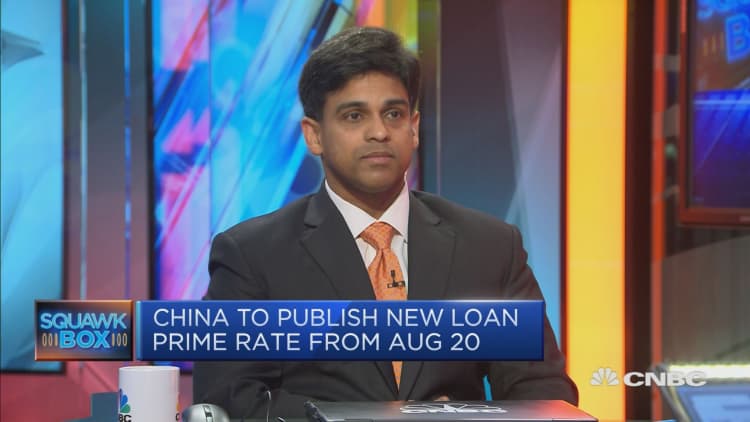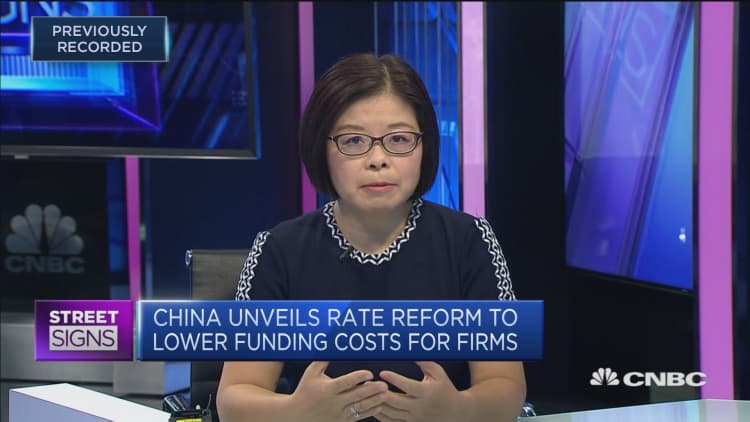China's central bank has changed the way commercial lenders set interest rates for loans — a move expected to bring borrowing costs lower at a time when the Chinese economy needs a boost.
Growth in China is slowing down as its trade war with the U.S. looks set to intensify in the coming months. Chinese authorities have used both monetary and fiscal measures to lift economic activity, but analysts say certain segments of the economy could use more help.
"This is a welcomed move in lowering the costs of borrowing especially for smaller businesses, and it comes at an important time as China's GDP growth is at risk of falling below 6% in 2020 as US tariffs on Chinese goods are repeatedly ramped up," analysts from Singapore's United Overseas Bank wrote in a Monday note.
The International Monetary Fund has projected China's growth to be at 6.2% in 2019 and 6.0% in 2020. But those forecasts were made before the latest escalation in the U.S.-China friction, which is expected to lead to more tariffs being slapped on Chinese goods in September and December.
Interest rate reforms
Unlike the U.S. Federal Reserve, China's central bank — the People's Bank of China — doesn't have a single primary monetary policy tool. Instead, the PBOC uses multiple methods to control money supply and interest rates in the world's second-largest economy.
One of those tools is the loan prime rate — or the interest rate that banks charge their most creditworthy customers. Beijing announced Saturday that the LPR will be revamped from this month.
The changes include:
- Pushing commercial lenders to use the loan prime rate, instead of the benchmark lending rate, as a reference to price new loans.
- Increasing the number of financial institutions that can participate in submitting LPR quotations, from 10 to 18 entities.
- Setting the loan prime rate on the 20th of every month, instead of daily.
- Requiring the panel banks to link their LPR quotations to the rate of medium-term lending facility (MLF), a funding facility the PBOC extends to commercial lenders.

The loan prime rate, introduced in October 2013, was meant to better reflect market demand for funds compared to the benchmark rate — but it didn't work out that way.
One reason is that many banks, in a bid to protect their profit margins, refused to price their loans much lower than the benchmark lending rate — which has not been adjusted since October 2015. Given that the loan prime rate is charged to the best and least risky customers, it became the unofficial minimum interest rates on bank loans in China.
Cheaper bank loans
The PBOC has said the implicit lower bound of bank lending rates is "an important reason" why overall borrowing costs in China have not declined even though other interest rates more sensitive to market demand and supply have moved down.
Another tool the Chinese central bank uses to adjust monetary policy is the medium-term lending facility rate. It is considered more aligned to supply-demand dynamics in China's money markets.
The one-year rate for the MLF last stood at around 3.3% — lower than the central bank's benchmark lending rate of 4.35%.

Linking the new loan prime rate to the medium-term lending facility rate is expected to bring down the LPR, leading to a decline in overall borrowing costs.
That already has some effect. On Tuesday, the first day of the new reforms, the new one-year loan prime rate was set at 4.25% — down from 4.31% previously; while the newly introduced five-year loan prime rate was fixed at 4.85% — below the five-year benchmark of 4.9%.
That should, theoretically, lead to lower interest rates on new bank loans for businesses and households.
More effective monetary policy
Beijing has for many years tried to change the way interest rates work in its economy. It wants to be more in line with the practices of central banks in major economies, which mainly adjust interest rates on short-term funds to influence borrowing costs in the broader economy.
China maintains a so-called command economy — or a centrally planned economy, where its central bank dictates where interest rates for bank loans and deposits should be.
But as the Chinese economy opens up and increasingly plugs into the global marketplace, the PBOC has through the years given commercial lenders more leeway in setting rates.

Even so, banks preferred to use the PBOC's benchmark rates as a reference to price their loans — limiting the flow through of monetary policy changes to the broader economy. But the latest interest rate reforms could make monetary support measures more effective at a time when the Chinese economy is being challenged by the trade war with the U.S.
"This change does not automatically bring interest rate reduction, but it sets the stage for the PBoC to achieve that," analysts from French bank Societe Generale wrote in a Sunday note. "We do think that the PBoC will try hard to make lower interest rates happen with the help of the new system, because the economy is in great need of more monetary policy support."


